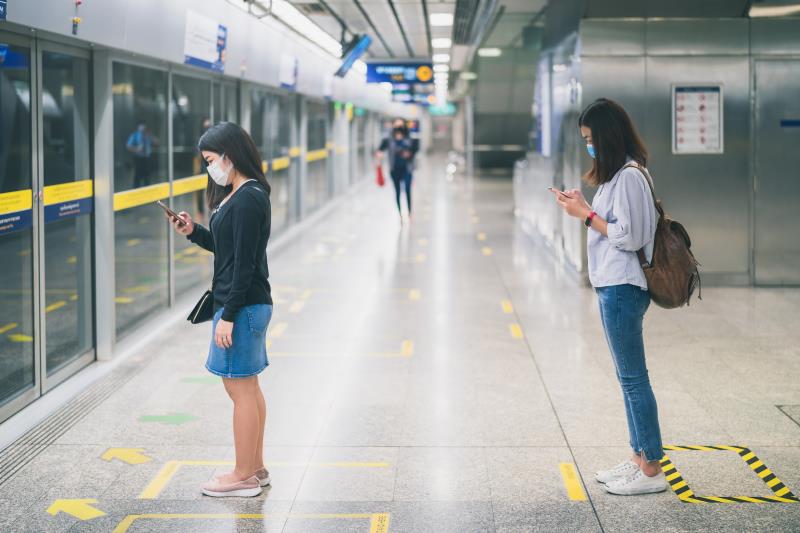Physical distancing, face masks key to reducing COVID-19 spread





Physical distancing of ≥1 m and use of face masks and eye protection reduced the risk of COVID-19 transmission in healthcare settings and the community, according to a systematic review and meta-analysis.
“[T]he results of our current review support the implementation of a policy of physical distancing of at least 1 m and, if feasible, 2 m or more. These data also suggest that wearing face masks protects people … against infection by these coronaviruses, and that eye protection could confer additional benefit,” said the authors.
From a review of 172 observational studies from 16 countries, the meta-analysis included 44 comparative studies (n=25,697) on SARS-CoV-2 (n=6,674), Middle East respiratory syndrome (MERS; n=3,095), and SARS (n=15,928) in healthcare and non-healthcare settings, assessing the transmission of these diseases between individuals with confirmed or probable infection and their close contacts.
Physical distancing of ≥1 m was associated with reduced virus transmission compared with distancing of <1 m (pooled adjusted odds ratio [adjOR], 0.18, 95 percent confidence interval [CI], 0.09–0.38; risk difference [RD], -10.2 percent [moderate certainty]), with transmission further reduced with increased distance (relative risk [RR] difference, 2.02 per 1 m increase; pinteraction=0.041 [moderate certainty]). [Lancet 2020;395:1973-1987]
Among those exposed to infected individuals, infection risk was reduced with face mask use, regardless of type (adjOR, 0.15, 95 percent CI, 0.07–0.34; RD, -14.3 percent [low certainty]). However, it appeared that N95 or similar respirators conferred better protection than disposable surgical masks or other similar masks (eg, 12–16-layer cotton masks; adjOR, 0.04 vs 0.33; pinteraction=0.090 [moderate credibility]). After adjusting for mask type, reduced infection risk was apparent in both healthcare settings and the community.
Infection risk was also reduced with use of eye protection (eg, goggles, face shields; adjOR, 0.22, 95 percent CI, 0.12–0.39; RD, -10.6 percent [low certainty]).
“Across 24 studies of all three viruses including 50,566 individuals, most participants found these personal protection strategies acceptable, feasible, and reassuring, but noted harms and challenges including frequent discomfort and facial skin breakdown, increased difficulty communicating clearly, and perceived reduced empathy from care providers by those they were caring for,” noted co-author Dr Sally Yaacoub from the American University of Beirut, Lebanon.
Applicability in the real world
“For the currently foreseeable future (ie, until a safe and effective vaccine or treatment becomes available), COVID-19 prevention will continue to rely on non-pharmaceutical interventions, including pandemic mitigation in community settings,” said the authors.
“Our findings … provide robust estimates to inform models and contact tracing used to plan and strategize for pandemic response efforts at multiple levels,” they said.
“In regions with a high incidence of COVID-19, universal face mask use combined with physical distancing could reduce the rate of infection (flatten the curve), even with modestly effective masks. Universal face mask use might enable safe lifting of restrictions in communities seeking to resume normal activities and could protect people in crowded public settings and within households,” stated Professors Raina MacIntyre from the University of New South Wales, Sydney, Australia, and Quanyi Wang from the Beijing Center for Disease Prevention and Control, Beijing, China, in a commentary. [Lancet 2020;395:1950-1951]
The authors highlighted the concern regarding the potential shortage of face masks that may accompany widespread use.
“With respirators such as N95s, surgical masks, and eye protection in short supply, and desperately needed by healthcare workers on the front lines of treating COVID-19 patients, increasing and repurposing of manufacturing capacity is urgently needed to overcome global shortages,” pointed out co-author Assistant Professor Derek Chu from McMaster University, Hamilton, Ontario, Canada.
“[As such,] solutions should be found for making face masks available to the general public,” he added. “However, people must be clear that wearing a mask is not an alternative to physical distancing, eye protection, or basic measures such as hand hygiene, but might add an extra layer of protection.”
The suggested difference in effectiveness by mask type is also pertinent, said MacIntyre and Wang. “This finding is vital to inform the proliferation of home-made cloth mask designs, many of which are single-layered. A well-designed cloth mask should have water-resistant fabric, multiple layers, and good facial fit,” they said.
In addition, the findings call for a change of guidelines among healthcare workers, they continued. “For healthcare workers on COVID-19 wards, a respirator should be the minimum standard of care. This study … should prompt a review of all guidelines that recommend a medical mask for health workers caring for COVID-19 patients. Although medical masks do protect, the occupational health and safety of health workers should be the highest priority and the precautionary principle should be applied,” they said.
The small number of studies in non-healthcare settings and the evidence primarily derived from studies on SARS and MERS, were considered limitations. Effect of duration of exposure on transmission risk was also not assessed.
“Further high-quality research, including randomized trials of the optimum physical distance and the effectiveness of different types of masks in the general population and for healthcare workers’ protection, is urgently needed,” the authors said.